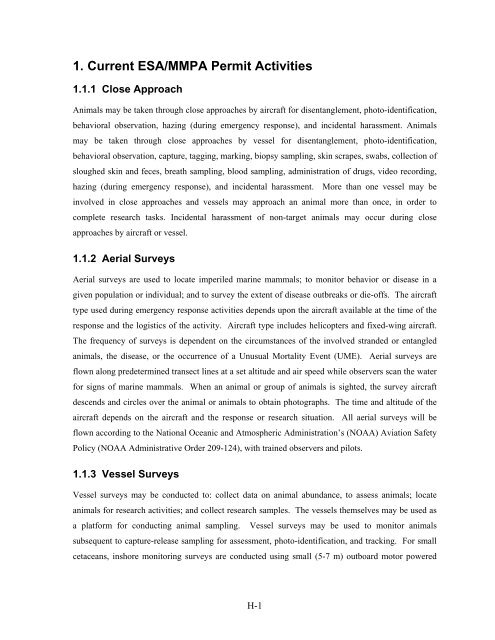Volume III, Appendices EM - National Marine Fisheries Service ...
Volume III, Appendices EM - National Marine Fisheries Service ...
Volume III, Appendices EM - National Marine Fisheries Service ...
You also want an ePaper? Increase the reach of your titles
YUMPU automatically turns print PDFs into web optimized ePapers that Google loves.
1. Current ESA/MMPA Permit Activities<br />
1.1.1 Close Approach<br />
Animals may be taken through close approaches by aircraft for disentanglement, photo-identification,<br />
behavioral observation, hazing (during emergency response), and incidental harassment. Animals<br />
may be taken through close approaches by vessel for disentanglement, photo-identification,<br />
behavioral observation, capture, tagging, marking, biopsy sampling, skin scrapes, swabs, collection of<br />
sloughed skin and feces, breath sampling, blood sampling, administration of drugs, video recording,<br />
hazing (during emergency response), and incidental harassment. More than one vessel may be<br />
involved in close approaches and vessels may approach an animal more than once, in order to<br />
complete research tasks. Incidental harassment of non-target animals may occur during close<br />
approaches by aircraft or vessel.<br />
1.1.2 Aerial Surveys<br />
Aerial surveys are used to locate imperiled marine mammals; to monitor behavior or disease in a<br />
given population or individual; and to survey the extent of disease outbreaks or die-offs. The aircraft<br />
type used during emergency response activities depends upon the aircraft available at the time of the<br />
response and the logistics of the activity. Aircraft type includes helicopters and fixed-wing aircraft.<br />
The frequency of surveys is dependent on the circumstances of the involved stranded or entangled<br />
animals, the disease, or the occurrence of a Unusual Mortality Event (UME). Aerial surveys are<br />
flown along predetermined transect lines at a set altitude and air speed while observers scan the water<br />
for signs of marine mammals. When an animal or group of animals is sighted, the survey aircraft<br />
descends and circles over the animal or animals to obtain photographs. The time and altitude of the<br />
aircraft depends on the aircraft and the response or research situation. All aerial surveys will be<br />
flown according to the <strong>National</strong> Oceanic and Atmospheric Administration’s (NOAA) Aviation Safety<br />
Policy (NOAA Administrative Order 209-124), with trained observers and pilots.<br />
1.1.3 Vessel Surveys<br />
Vessel surveys may be conducted to: collect data on animal abundance, to assess animals; locate<br />
animals for research activities; and collect research samples. The vessels themselves may be used as<br />
a platform for conducting animal sampling. Vessel surveys may be used to monitor animals<br />
subsequent to capture-release sampling for assessment, photo-identification, and tracking. For small<br />
cetaceans, inshore monitoring surveys are conducted using small (5-7 m) outboard motor powered<br />
H-1
















